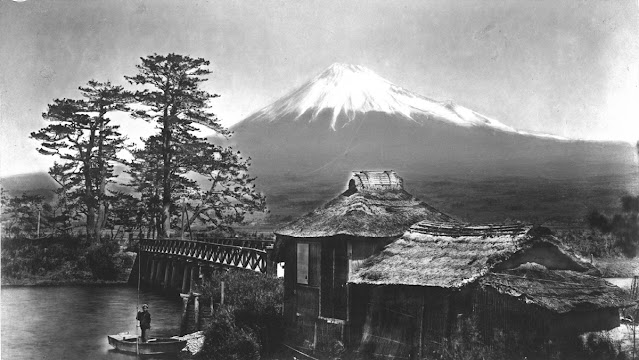T. ENAMI NOBUKUNI / 江南 信國 (1859 -1929)
Mount Fuji (3,776 m - 12,389 ft)
Japan
In Mount Fuji, colorized gelatine print, 1880
The mountain
Mount Fuji or Fujiyama / 富士山 It is located on Honshu Island and is the highest mountain peak in Japan
at 3,776.24 m (12,389 ft).
Several names are attributed to it: "Fuji-san", "Fujiyama" or, redundantly, "Mt. Fujiyama". Usually Japanese
speakers refer to the mountain as "Fuji-san". The other Japanese names
for Mount Fuji, have become obsolete or poetic like: Fuji-no-Yama
(ふじの山 - The Mountain of Fuji), Fuji-no-Takane (ふじの高嶺- The High Peak of
Fuji), Fuyō-hō (芙蓉峰 - The Lotus Peak), and Fugaku (富岳/富嶽), created by
combining the first character of 富士, Fuji, and 岳, mountain.
Mount Fuji is an active stratovolcano that last erupted in 1707–08.
Mount Fuji lies about 100 kilometres (60 mi) south-west of Tokyo, and
can be seen from there on a clear day.
Mount Fuji's exceptionally symmetrical cone, which is snow-capped
several months a year, is a well-known symbol of Japan and it is
frequently depicted in art and photographs, as well as visited by
sightseers and climbers.
Mount Fuji is one of Japan's Three Holy Mountains (三霊山) along with Mount
Tate and Mount Haku. It is also a Special Place of Scenic Beauty and
one of Japan's Historic Sites.
It was added to the World Heritage List as a Cultural Site on June 22,
2013. As per UNESCO, Mount Fuji has “inspired artists and poets and been
the object of pilgrimage for centuries”. UNESCO recognizes 25 sites of
cultural interest within the Mt. Fuji locality. These 25 locations
include the mountain itself, Fujisan Hongū Sengen Shrine and six other
Sengen shrines, two lodging houses, Lake Yamanaka, Lake Kawaguchi, the
eight Oshino Hakkai hot springs, two lava tree molds, the remains of the
Fuji-kō cult in the Hitoana cave, Shiraito Falls, and Miho no Matsubara
pine tree grove; while on the low alps of Mount Fuji lies the Taisekiji
temple complex, where the central base headquarters of Nichiren Shoshu
Buddhism is located.
The photographer
T. Enami / 江南 信國 or Enami Nobukuni was the trade name of a Meiji period Japanese photographer. The T. of his trade name is thought to have stood for Toshi, though he never spelled it out on any personal or business document.
Born in Edo (now Tokyo) during the Bakumatsu era, Enami was first a student of, and then an assistant to the well known photographer and collotypist, Ogawa Kazumasa. Enami relocated to Yokohama, and opened a studio on Benten-dōri (
Benten Street) in 1892. Just a few doors away from him was the studio of the already well known Tamamura Kōzaburō. He and Enami would work together on at least three related projects over the years.
Enami became quietly unique as the only photographer of that period known to work in all popular formats, including the production of large-format photographs compiled into what are commonly called "
Yokohama Albums". Enami went on to become Japan's most prolific photographer of small-format images such as the stereoview and glass lantern-slides. The best of these were delicately hand-tinted. His images in all formats eventually appeared in books and periodicals having press-runs in the millions. The Japanese stereoview lines of at least three major American publishers were made up entirely of T. Enami images.
Enami survived the 1923 Great Kantō earthquake, and rebuilt his studio which had been destroyed by the quake and subsequent fire. After his death at age 70 in 1929, his first son Tamotsu took over the studio until it was once again demolished in 1945 by the Allied bombing of Yokohama during World War II.
Because Tamotsu shared the initial "T" with his father, photo-historians later confused attribution of the father's photographs with those produced by his son. Terry Bennett, in his book
Photography in Japan 1853–1912 offered interesting commentary concerning the "father or son" attribution problem. The Enami family in Yokohama later resolved the mystery: Tamotsu was not a photographer, and T. Enami never stood for Tamotsu Enami. Rather, the son maintained the studio, and continued the production and sale of his father's old photographs. Fortunately, due to sharing the same first-name initial with his father, he didn't have to change the letterheads or labels of the company ephemera. These revelations, and other biographical data appeared in an essay and stereoview index entry written by Okinawa-based photo researcher Rob Oechsle, and published in Bennett's follow-up volume,
Old Japanese Photographs – Collectors' Data Guide.
Philbert Ono of Photo Guide Japan has also speculated on the possibility that T. Enami intentionally named his son with a leading T in the hope that he would someday take over the studio.
Perhaps the greatest posthumous honor conferred on Enami was the selection of one of his images to be the sole inset-photograph appearing on the first-edition cover of the monumental Odyssey,
The Art of Photography at National Geographic. Early in their history, Enami had been a contributing photographer to the magazine.
_______________________________
2019 - Wandering Vertexes...
by Francis Rousseau


















